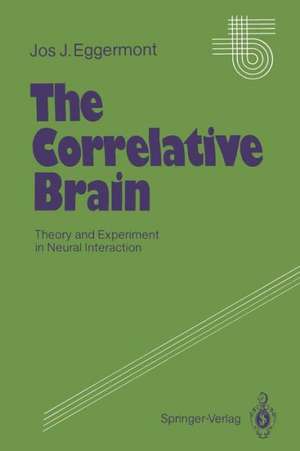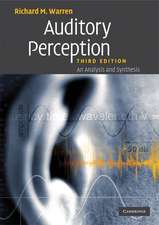The Correlative Brain: Theory and Experiment in Neural Interaction: Studies of Brain Function, cartea 16
Autor Jos J. Eggermonten Limba Engleză Paperback – 21 mai 2012
Din seria Studies of Brain Function
- 15%
 Preț: 631.72 lei
Preț: 631.72 lei - 15%
 Preț: 636.45 lei
Preț: 636.45 lei - 15%
 Preț: 647.73 lei
Preț: 647.73 lei - 15%
 Preț: 584.58 lei
Preț: 584.58 lei -
 Preț: 383.33 lei
Preț: 383.33 lei - 18%
 Preț: 784.13 lei
Preț: 784.13 lei -
 Preț: 394.51 lei
Preț: 394.51 lei - 15%
 Preț: 640.06 lei
Preț: 640.06 lei - 15%
 Preț: 641.71 lei
Preț: 641.71 lei - 15%
 Preț: 639.41 lei
Preț: 639.41 lei - 15%
 Preț: 642.03 lei
Preț: 642.03 lei - 18%
 Preț: 721.63 lei
Preț: 721.63 lei - 15%
 Preț: 640.24 lei
Preț: 640.24 lei - 15%
 Preț: 632.37 lei
Preț: 632.37 lei - 15%
 Preț: 638.24 lei
Preț: 638.24 lei - 15%
 Preț: 639.41 lei
Preț: 639.41 lei
Preț: 641.71 lei
Preț vechi: 754.95 lei
-15% Nou
Puncte Express: 963
Preț estimativ în valută:
122.81€ • 127.74$ • 101.38£
122.81€ • 127.74$ • 101.38£
Carte tipărită la comandă
Livrare economică 12-26 aprilie
Preluare comenzi: 021 569.72.76
Specificații
ISBN-13: 9783642510359
ISBN-10: 3642510353
Pagini: 324
Ilustrații: XI, 307 p. 161 illus., 2 illus. in color.
Dimensiuni: 155 x 235 x 17 mm
Greutate: 0.45 kg
Ediția:Softcover reprint of the original 1st ed. 1990
Editura: Springer Berlin, Heidelberg
Colecția Springer
Seria Studies of Brain Function
Locul publicării:Berlin, Heidelberg, Germany
ISBN-10: 3642510353
Pagini: 324
Ilustrații: XI, 307 p. 161 illus., 2 illus. in color.
Dimensiuni: 155 x 235 x 17 mm
Greutate: 0.45 kg
Ediția:Softcover reprint of the original 1st ed. 1990
Editura: Springer Berlin, Heidelberg
Colecția Springer
Seria Studies of Brain Function
Locul publicării:Berlin, Heidelberg, Germany
Public țintă
ResearchCuprins
1 Single-Unit Analysis Versus Population Response Analysis.- 2 Outline of this Book.- 1 Information Coding.- 1.1 Information Coding and Transmission by Single Cells and Cell Populations.- 1.2 Cooperative Effects and Ensemble Coding.- 2 Spontaneous Activity.- 2.1 Noise or Information Carrier?.- 2.2 Quantification and Representation.- 2.3 The Auditory System.- 2.4 The Visual System.- 2.5 Other Brain Areas.- 2.6 Synthesis of Spontaneous Activity Phenomenology.- 3 Receptive Fields.- 3.1 Receptotopic and Nonreceptotopic Receptive Fields.- 3.2 Center-Surround Structure.- 3.3 Receptive Field Changes in Central Neurons: Feature Detectors?.- 3.4 Temporal Properties of the Receptive Field.- 4 Single-Neuron Models.- 4.1 Diffusion Models.- 4.2 Discrete Input Models.- 4.3 Neural Interaction — Black Box — Models.- 5 Neural Network Models.- 5.1 Neurons as Logical Switching Elements.- 5.2 Little-Neurons as Network Elements: Introduction of Probability.- 5.3 Statistical Theories of Memory.- 5.4 Statistical Neuromechanics.- 5.5 Neural Field Theories.- 5.6 Interaction in Neural Nets.- 6 Multiple Separate Recordings from Neural Nets.- 6.1 Recording from Multiple Sites in the Brain.- 6.2 Separating Multiple-Unit Spike Trains.- 7 Representation and Detection of Correlated Neural Activity.- 7.1 Representation of Multiple-Site Recorded Continuous Neural Activity.- 7.2 Representation of Multiunit Spike Trains.- 7.3 Cross-Correlation.- 7.4 Joint Peri-Stimulus-Time Scattergrams.- 7.5 A Hierarchy of Multiunit Representations.- 7.6 Correlation Analysis of Larger Numbers of Neural Units.- 7.7 Are Higher-Order Correlation Analyses Necessary?.- 7.8 Correcting Cross-Correlations for Effects of Stimulus Coupling 142.- 8 Correlated Neuronal Activity Observed in the Vertebrate Brain.- 8.1 The VisualSystem.- 8.2 The Auditory System.- 8.3 The Somatosensory System.- 8.4 Simultaneous Versus Sequential Single-Unit Recording.- 8.5 The Motor System.- 8.6 Comparison Between the Sensory and Motor Systems.- 8.7 Correlated Neural Activity and the State of the Animal.- 8.8 Correlated Neural Activity and Cognition.- 9 System Identification from Neural Correlation.- 9.1 Identification on the Basis of Continuous Input and Output Signals.- 9.2 Identification on the Basis of Continuous Input and Discrete Output.- 9.3 Identification Based upon Discrete Input and Discrete Output.- 9.4 Identification Based upon Discrete Input and Continuous Output.- 9.5 When Systems Identification Does Not Work.- 10 Plasticity — The Capacity to Change.- 10.1 The Developing Brain.- 10.2 The Adult Brain.- 10.3 Mechanisms and Models for Modifiable Synapses.- 11 Learning — The Cerebellum.- Box L, Anatomy, Physiology and Pharmacology of the Cerebellum.- 11.3 The Cerebellum as a Space-Time Metric.- 12 Learning — The Hippocampus.- 12.1 Types of Memory.- 12.2 Brain Structures Involved in Memory.- 12.3 A Mechanism of Memory Formation in the Hippocampus.- 12.4 Formal Models of Memory Formation.- 12.5 A Model for the Role of the Hippocampus in Memory.- 13 Learning — The Neocortex.- 13.1 The Neocortex: Pinnacle or Way-Station?.- 13.2 Development Aspects of Neocortical Organizations.- 13.3 The Neocortex as a Self-Organizing System.- 14 The Correlative Brain.- 14.1 Correlation, the Basic Mechanism of the Brain?.- 14.2 Topographic and Functional Brain Maps.- 14.3 Top-Down and Bottom-Up Approaches to Brain Function.- References.













